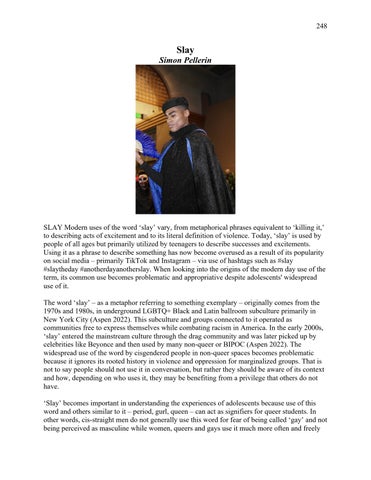248
Slay Simon Pellerin
SLAY Modern uses of the word ‘slay’ vary, from metaphorical phrases equivalent to ‘killing it,’ to describing acts of excitement and to its literal definition of violence. Today, ‘slay’ is used by people of all ages but primarily utilized by teenagers to describe successes and excitements. Using it as a phrase to describe something has now become overused as a result of its popularity on social media – primarily TikTok and Instagram – via use of hashtags such as #slay #slaytheday #anotherdayanotherslay. When looking into the origins of the modern day use of the term, its common use becomes problematic and appropriative despite adolescents' widespread use of it. The word ‘slay’ – as a metaphor referring to something exemplary – originally comes from the 1970s and 1980s, in underground LGBTQ+ Black and Latin ballroom subculture primarily in New York City (Aspen 2022). This subculture and groups connected to it operated as communities free to express themselves while combating racism in America. In the early 2000s, ‘slay’ entered the mainstream culture through the drag community and was later picked up by celebrities like Beyonce and then used by many non-queer or BIPOC (Aspen 2022). The widespread use of the word by cisgendered people in non-queer spaces becomes problematic because it ignores its rooted history in violence and oppression for marginalized groups. That is not to say people should not use it in conversation, but rather they should be aware of its context and how, depending on who uses it, they may be benefiting from a privilege that others do not have. ‘Slay’ becomes important in understanding the experiences of adolescents because use of this word and others similar to it – period, gurl, queen – can act as signifiers for queer students. In other words, cis-straight men do not generally use this word for fear of being called ‘gay’ and not being perceived as masculine while women, queers and gays use it much more often and freely
